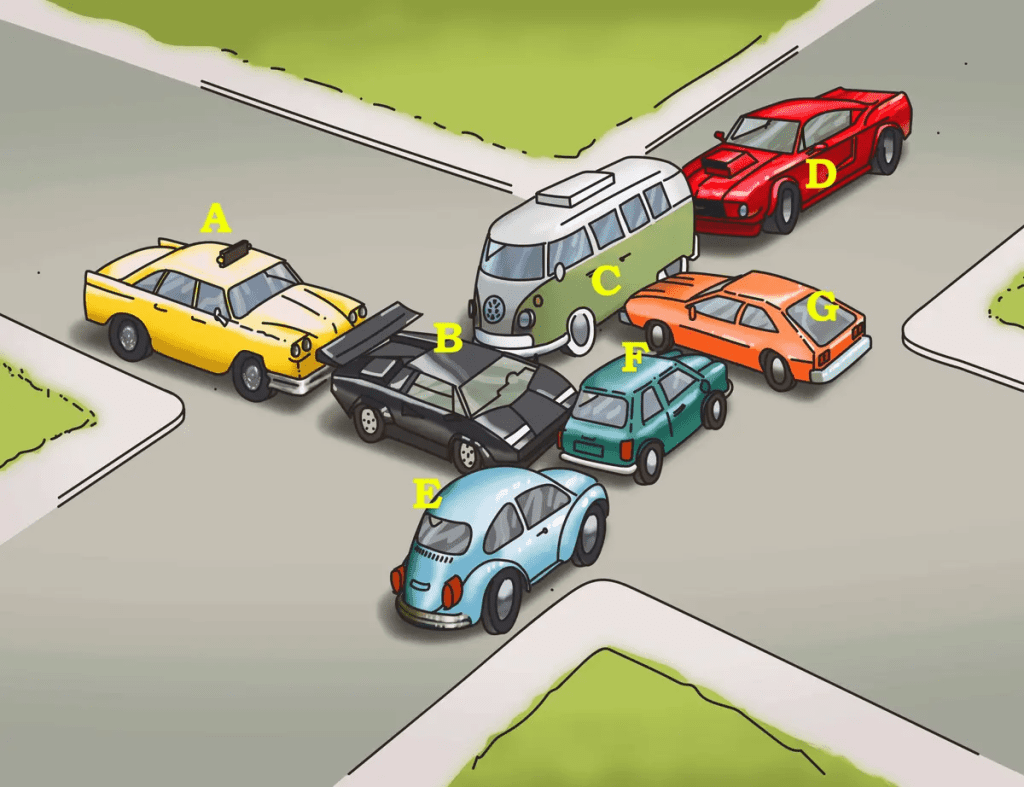Picture this: You’re heading home after a long, exhausting day when you hit an intersection where traffic is at a complete standstill.
Seven cars are gridlocked, each blocking the other’s way, and no one seems to know who should move first. It’s frustrating for everyone involved, but solving the puzzle requires patience, logic, and strategic thinking.

Now, you’ve found yourself tasked with an intriguing challenge: Which car must move first to break the deadlock and free the intersection?
The Scenario: An Intersection Gridlock
Let’s set the scene: There are seven cars, labeled A, B, C, D, E, F, and G, stuck at an intersection. Each car is blocking another, creating a chain of immobility. Figuring out who should make the first move might seem impossible at first, but there is a solution hidden within the chaos.
The key is to approach the problem systematically. You need to identify the one car that, when moved, will trigger a chain reaction that allows the others to follow. So, which car will set off this sequence of events?
Breaking Down the Puzzle: Who Moves First?
If you’re thinking it’s one of the cars in the front of the intersection, you might want to think again. Solving this traffic jam isn’t about who’s in the middle or who’s in the front—it’s about which vehicle can create space for others to move.
The solution lies with Car G, the orange Pinto. But why Car G?
Why Car G Is the Key to Solving the Traffic Jam
Let’s look at Car G’s position. It’s situated in such a way that if it moves backward, it creates enough room for the other cars to start moving. Here’s why Car G is the optimal first move:
- Car G backs up to create space behind it, opening up the gridlock and giving another car room to move.
- This initial move sets off a chain reaction, allowing the next car in the gridlock to move forward or turn.

By moving Car G first, the entire intersection begins to clear. Once Car G moves, Car F can proceed forward, which in turn allows Car E to shift and exit the gridlock. Eventually, each car finds a path out of the traffic jam in a smooth sequence.
The Chain Reaction: How the Puzzle Unfolds
To give you a clearer picture, here’s how the process works step by step:

- Car G reverses, creating space in the lane behind.
- Car F moves forward, further clearing the path.
- Car E then exits the gridlock, making more room for the next vehicles.
- Car B follows, driving forward and clearing the way for Car A.
- Finally, Cars D and C are free to move forward, and within minutes, the entire traffic jam is resolved.


What seemed like a frustrating, unsolvable mess is quickly resolved by identifying the one crucial move—starting with Car G.
Lessons Learned from This Brainteaser
This traffic jam puzzle isn’t just about solving a brainteaser; it teaches valuable lessons about problem-solving, strategy, and patience. Here are the key takeaways:
1. Patience and Observation Are Crucial
Rushing into a solution can often make the problem worse. In this case, taking the time to carefully observe the gridlock allowed you to identify the car that could initiate a solution. The same principle applies to many challenges in life—patience and observation lead to better outcomes.
2. Thinking Strategically
Sometimes, the solution isn’t obvious or straightforward. Solving problems requires thinking creatively and considering every option. By focusing on Car G, you discovered an unexpected yet effective solution. Thinking outside the box often reveals the best course of action.
3. One Small Move Can Create a Chain Reaction
This puzzle demonstrates how one small action can have a significant impact. In this case, moving one car set off a sequence that cleared the entire gridlock. The same concept applies in life—making a strategic first move can lead to resolving larger issues.
How Brainteasers Like This Improve Cognitive Skills
Beyond being a fun mental exercise, puzzles like this improve essential cognitive skills. By engaging in brainteasers, you sharpen critical thinking, logical reasoning, and problem-solving abilities. These puzzles require you to analyze complex situations, break them down, and find solutions—skills that are highly valuable in both professional and personal contexts.
The Takeaway: Strategy and Patience Unlock Solutions
This traffic jam puzzle was more than just a fun challenge; it’s a reminder of how strategic thinking and patience can solve even the trickiest problems. Whether in real life or when solving puzzles, starting with the right move can clear the way for everything else to fall into place.
Next time you face a challenge, remember this puzzle: sometimes the solution is as simple as identifying the one move that triggers a positive chain reaction.
Just like moving Car G, the right first step can make all the difference.








